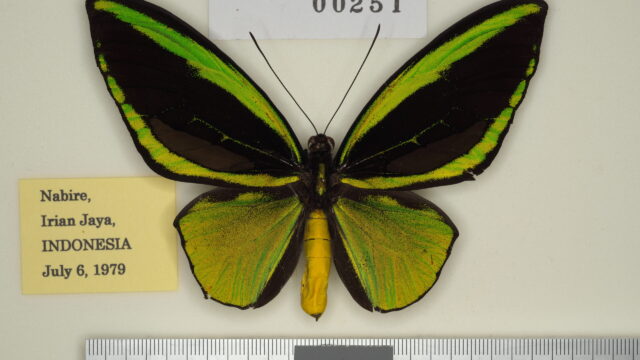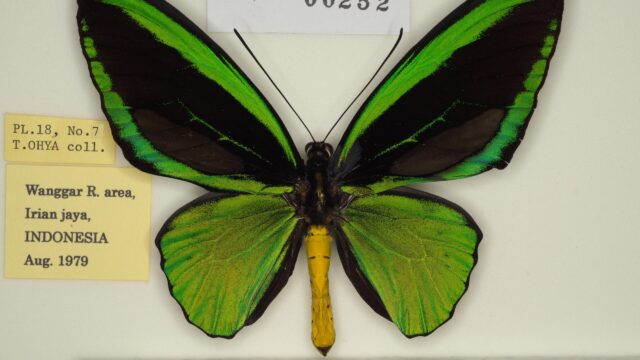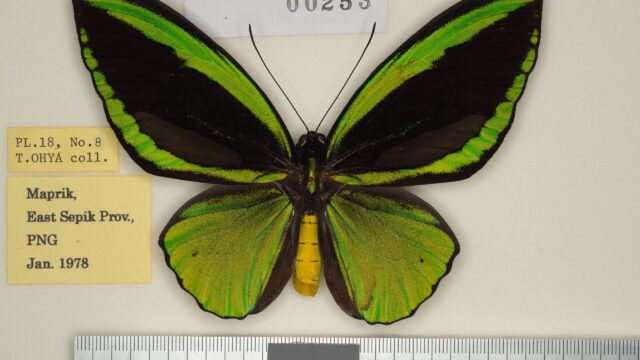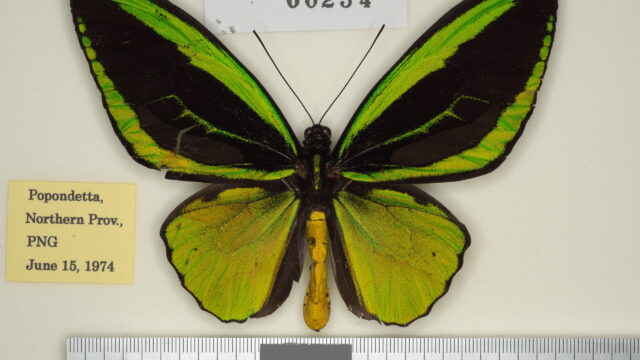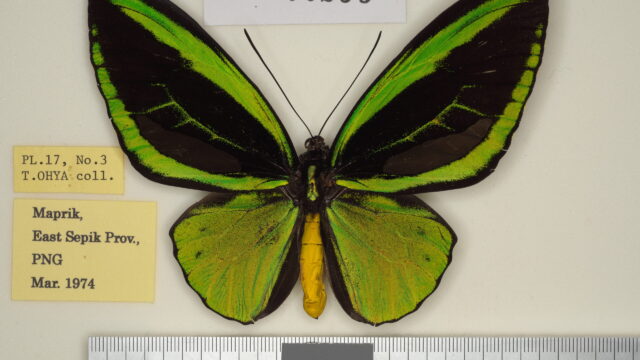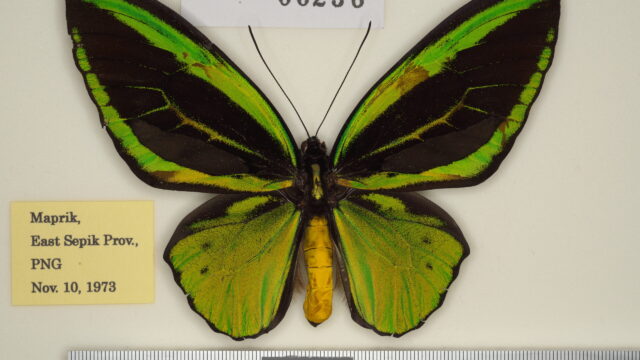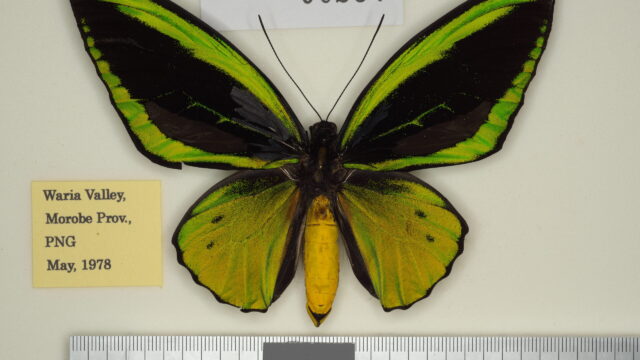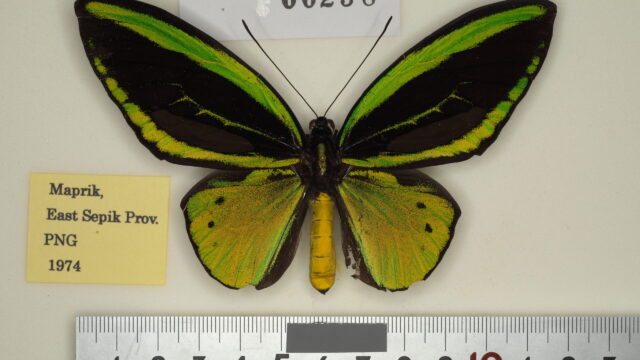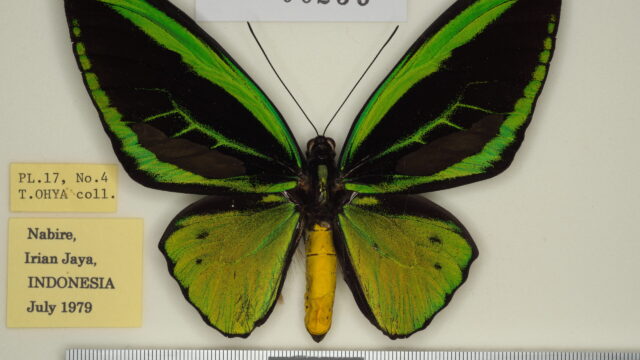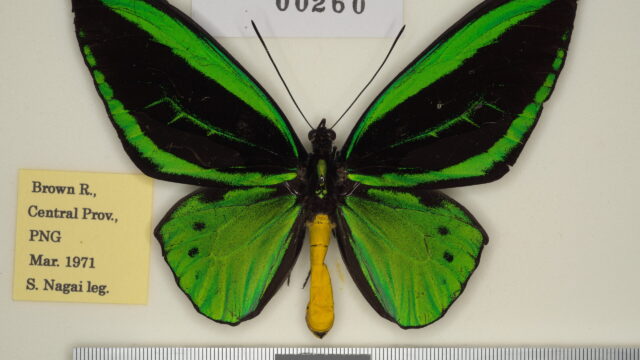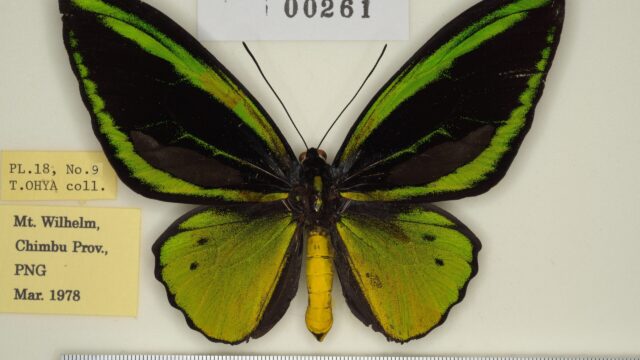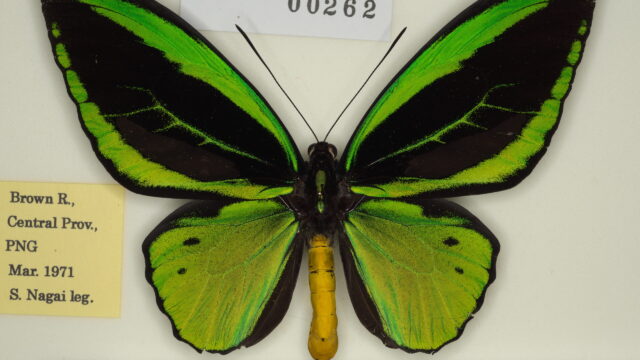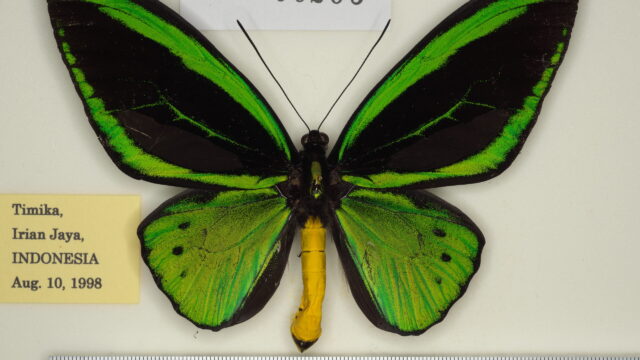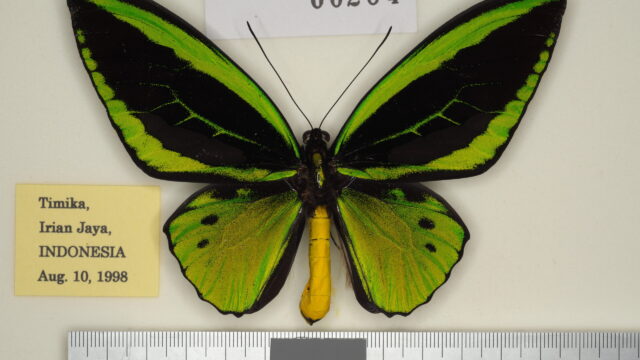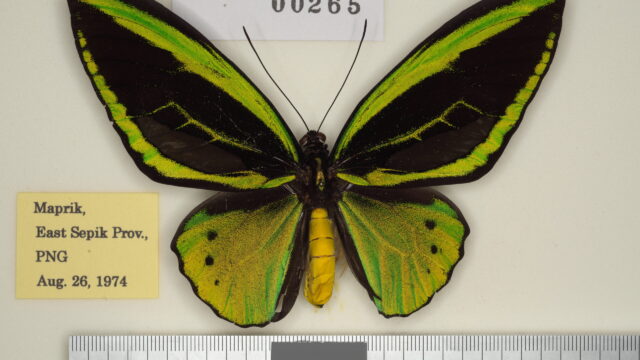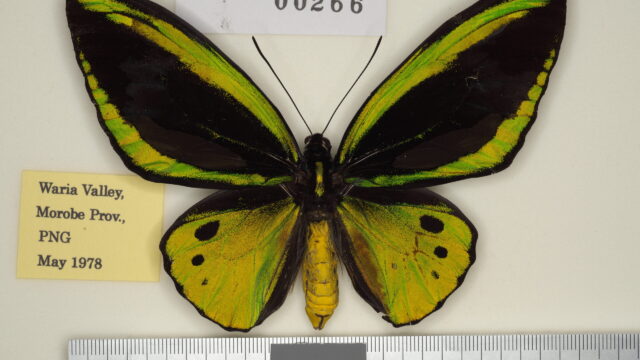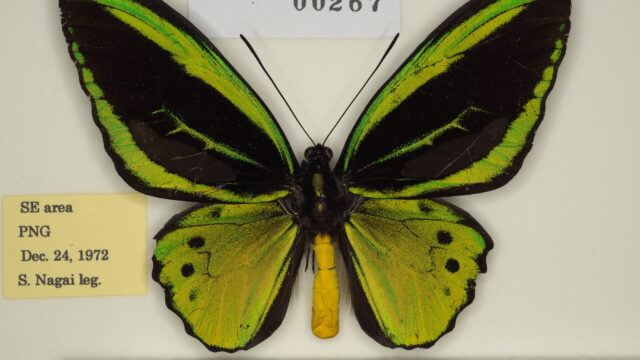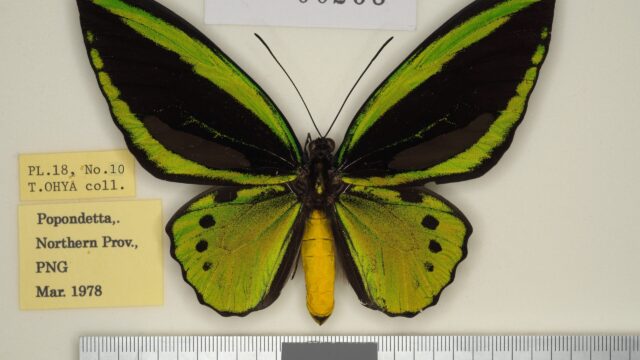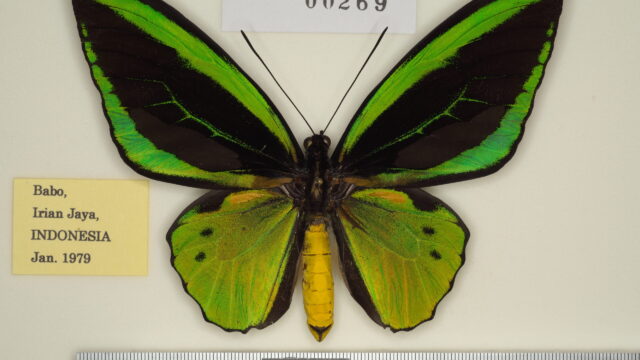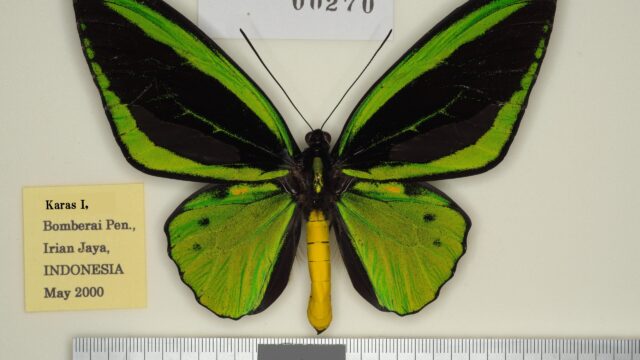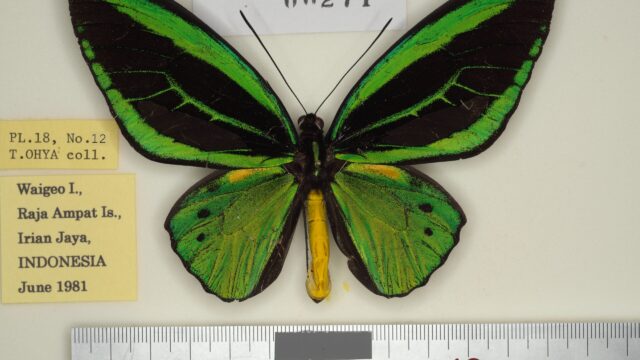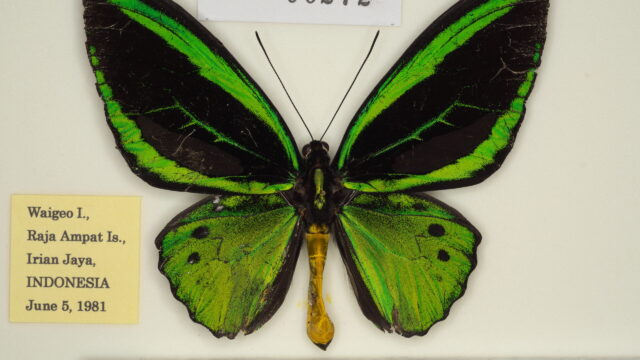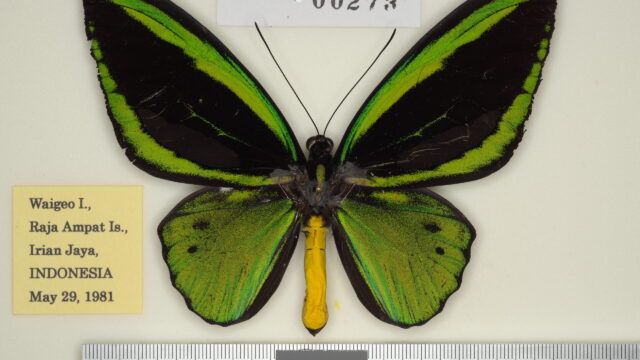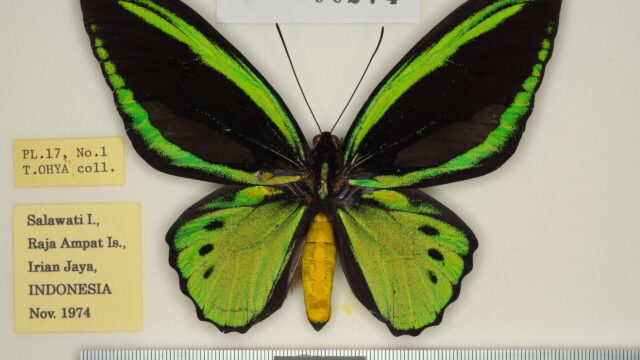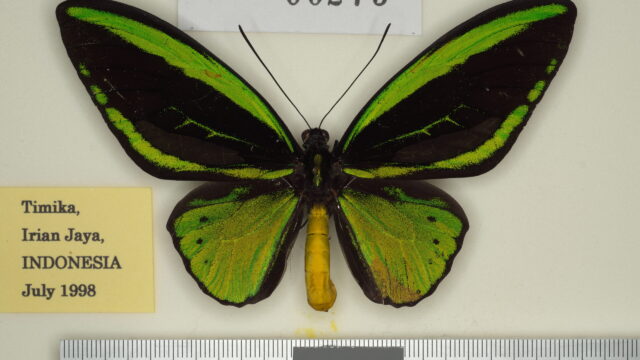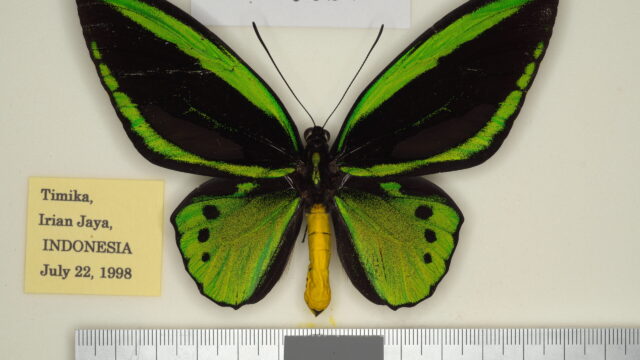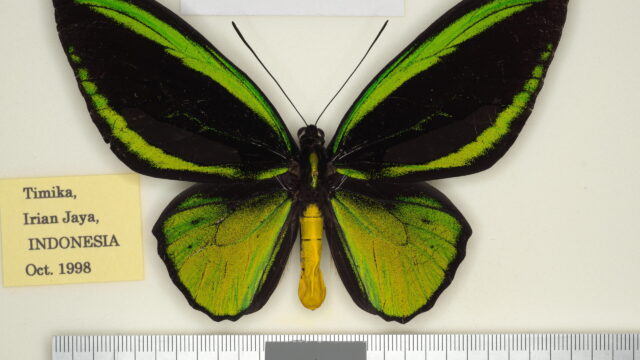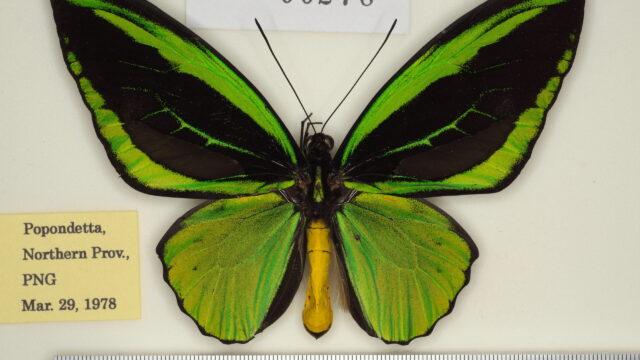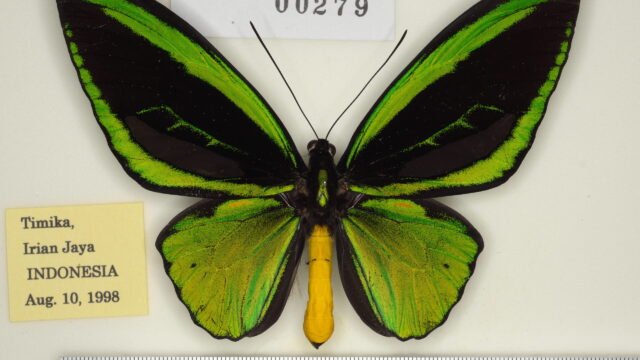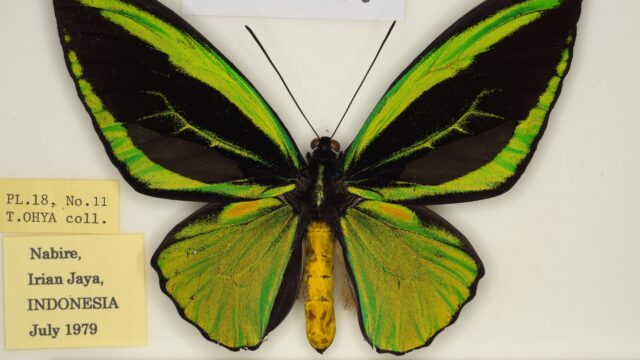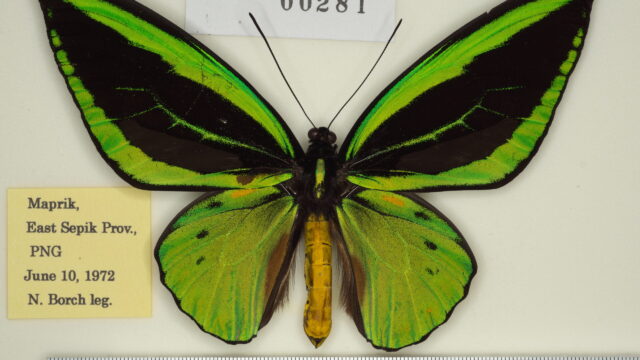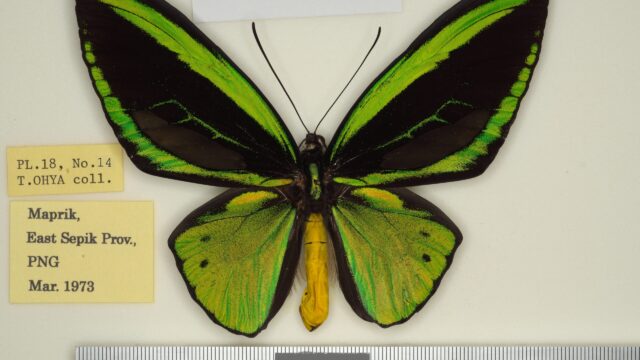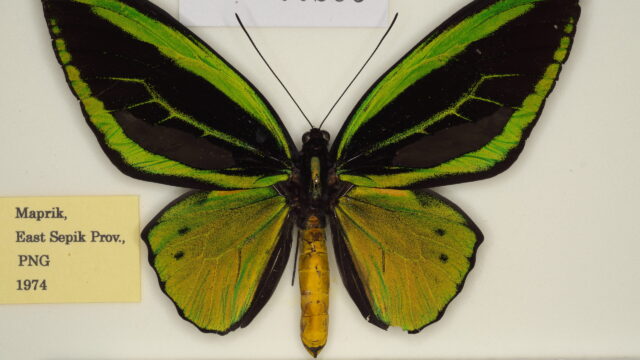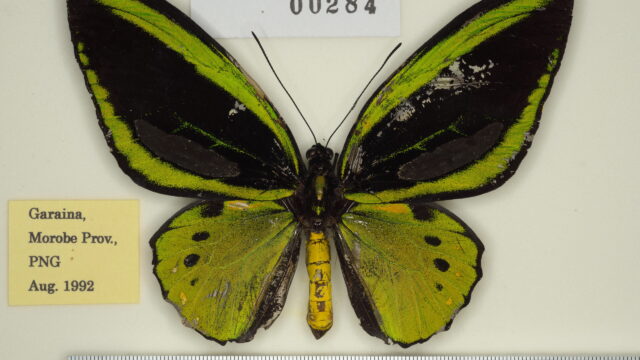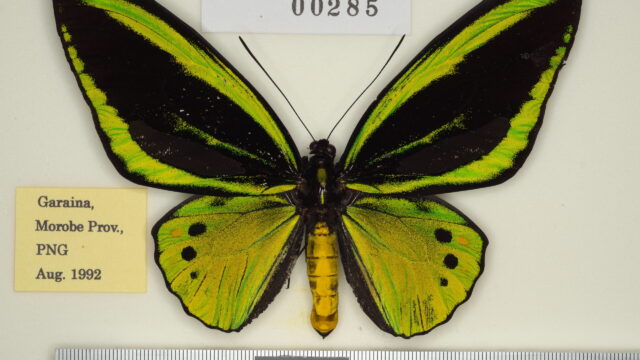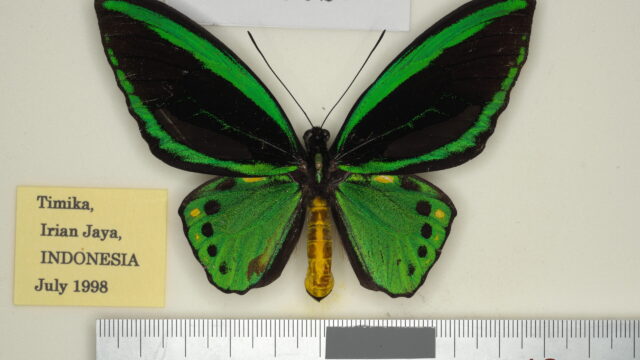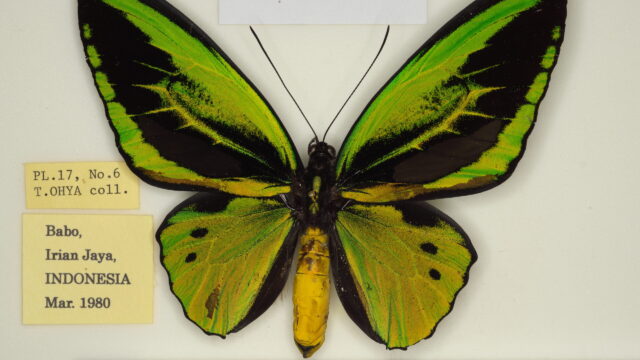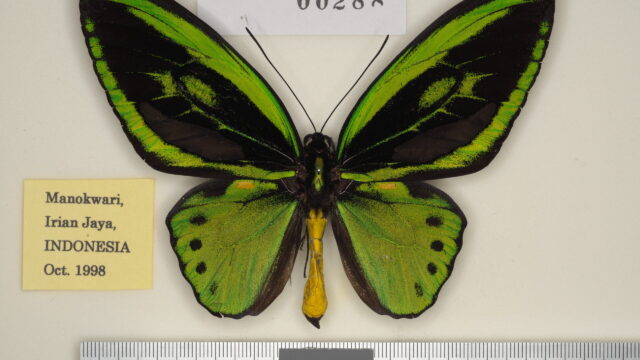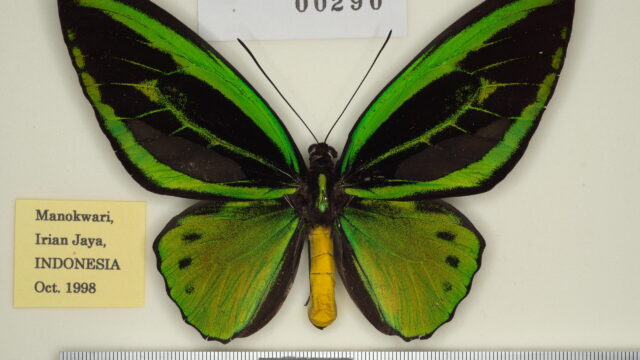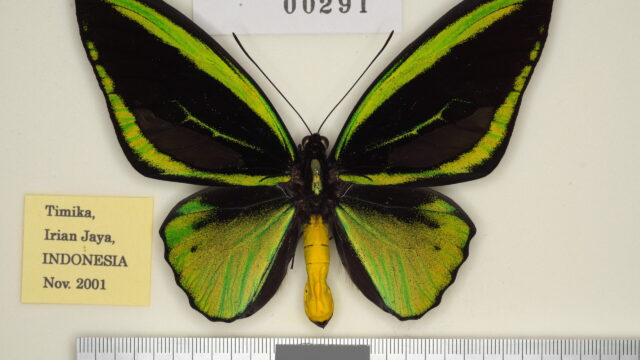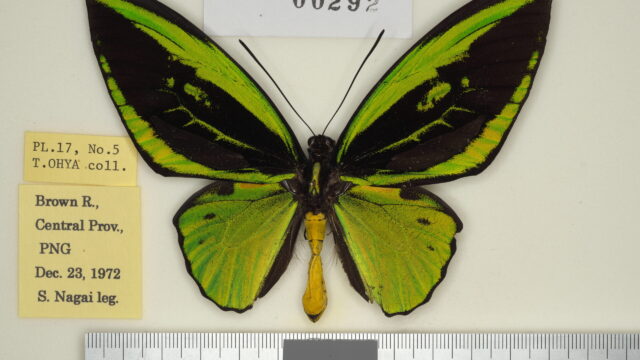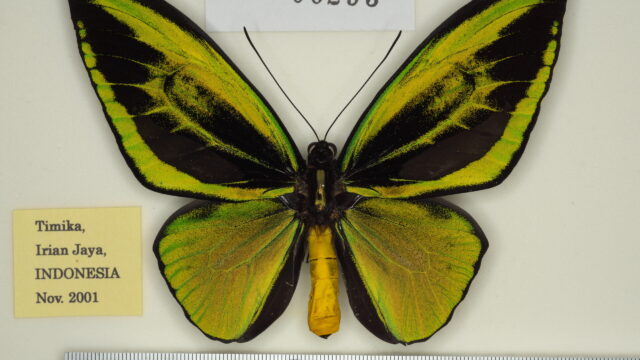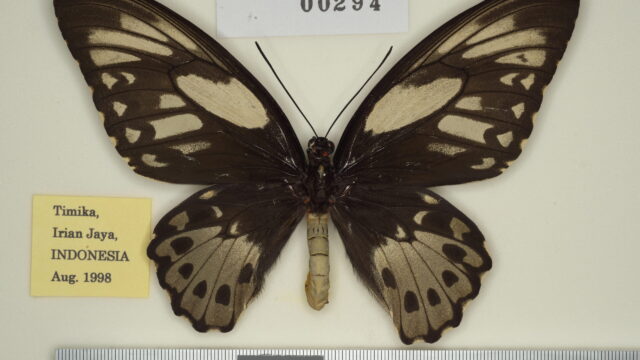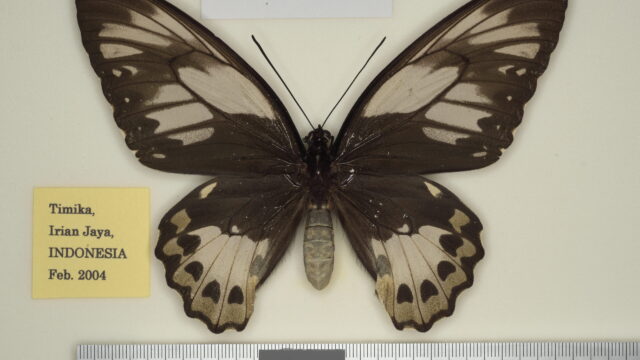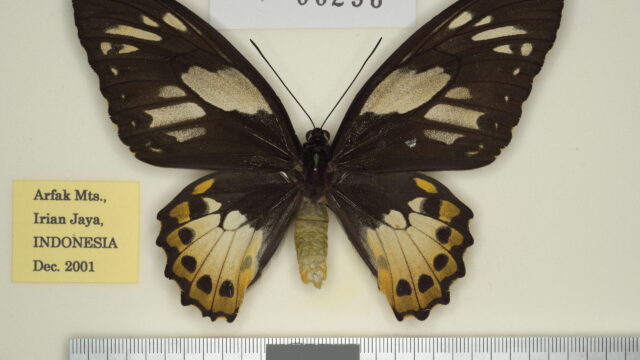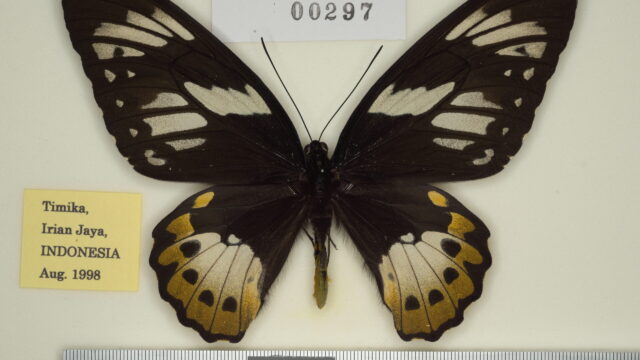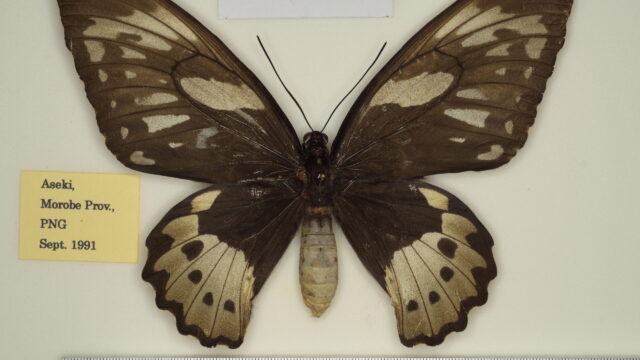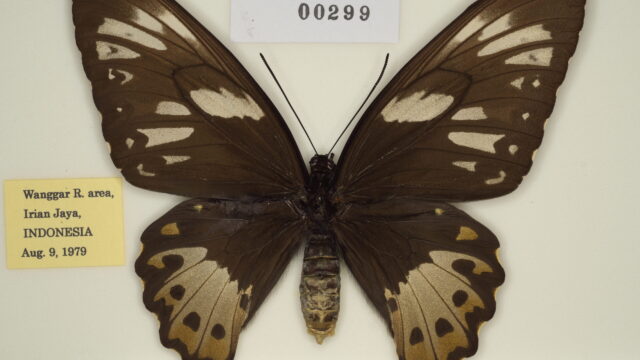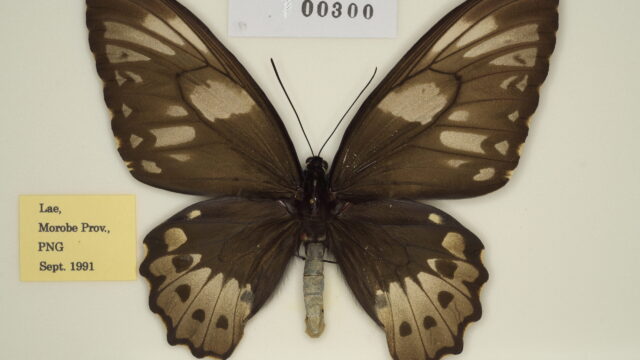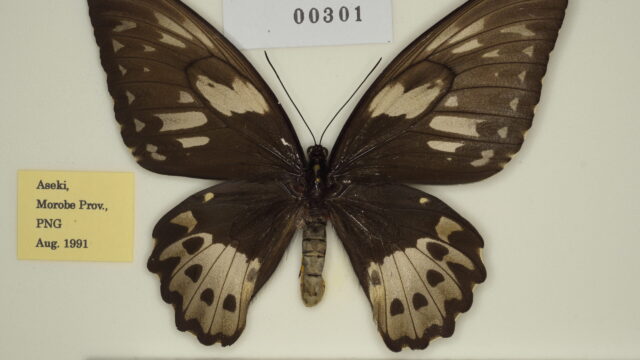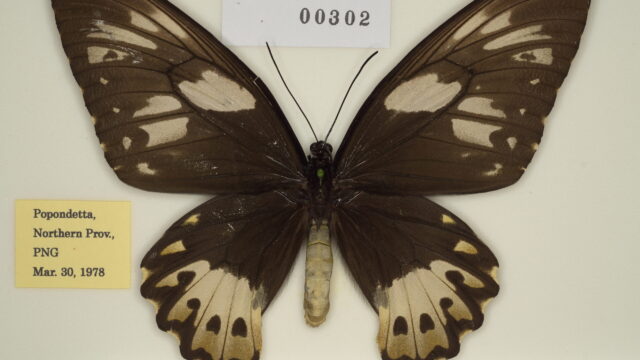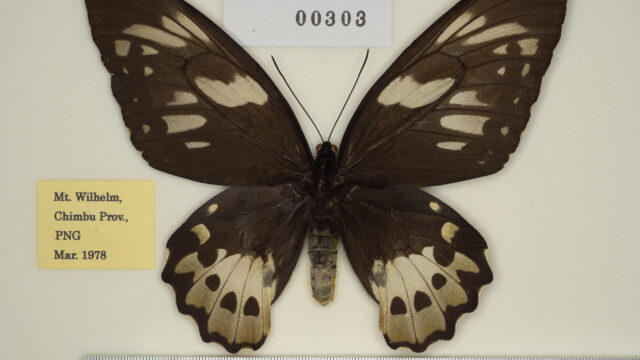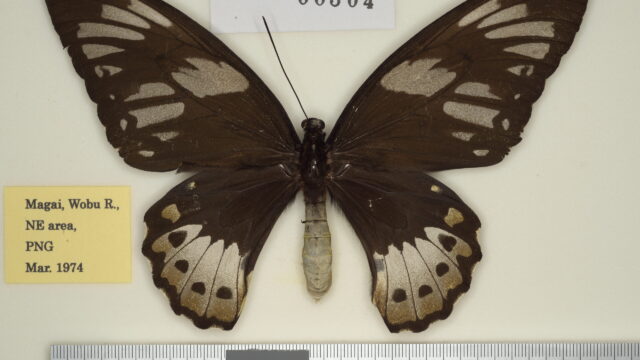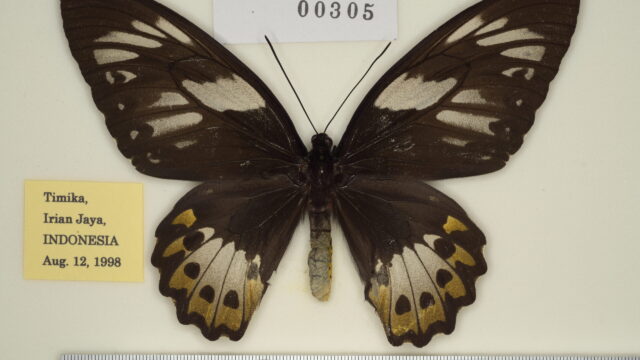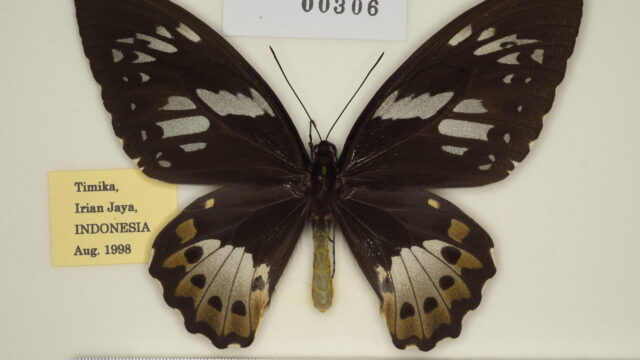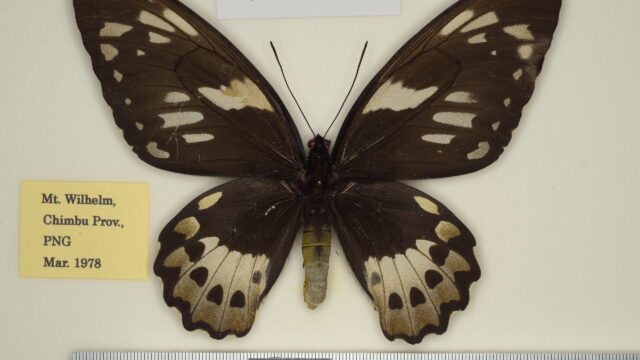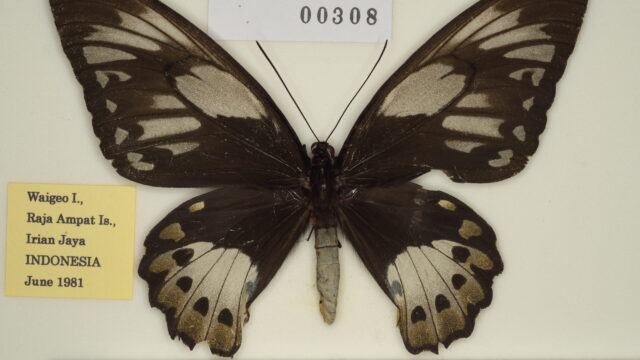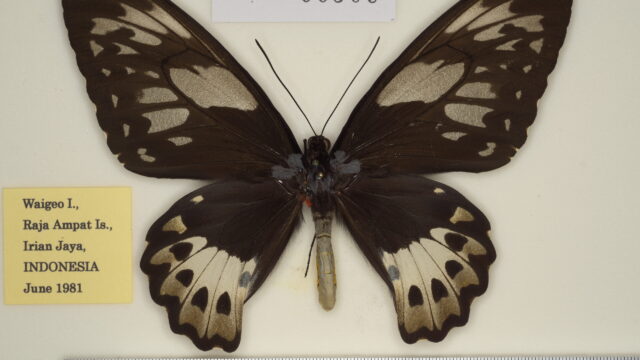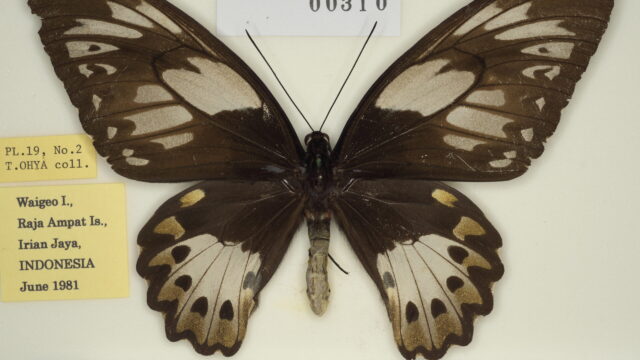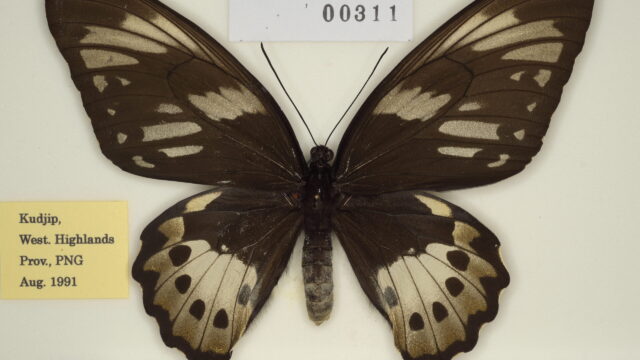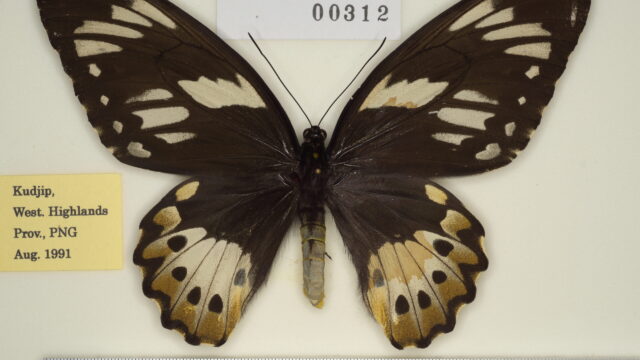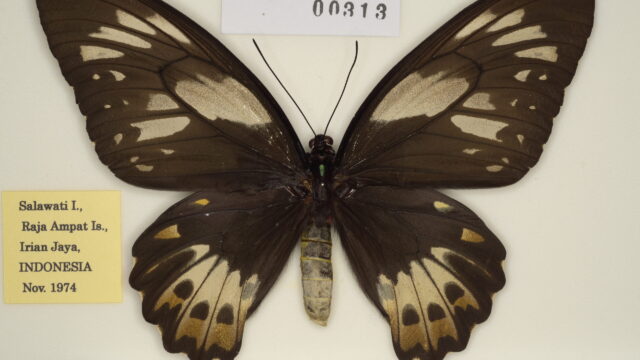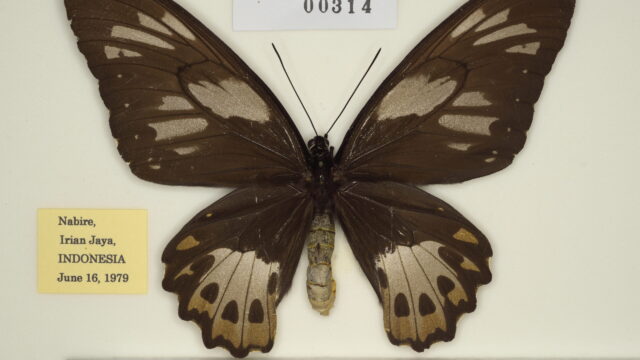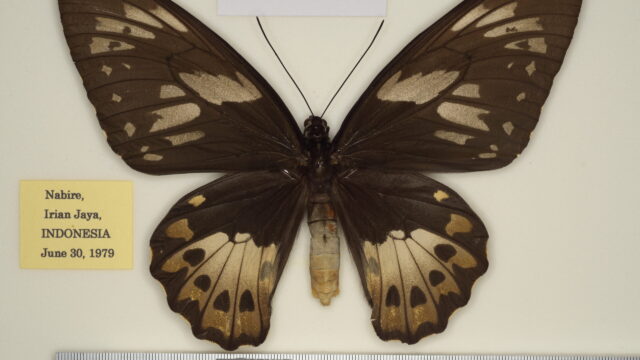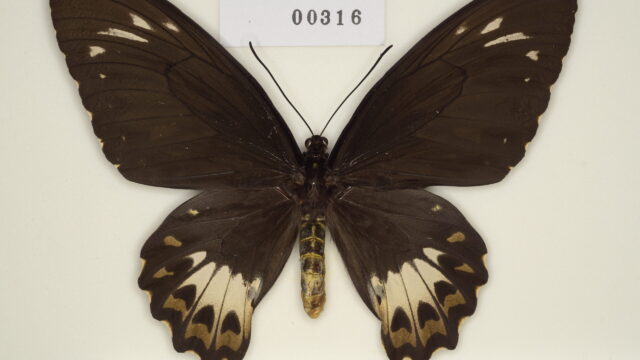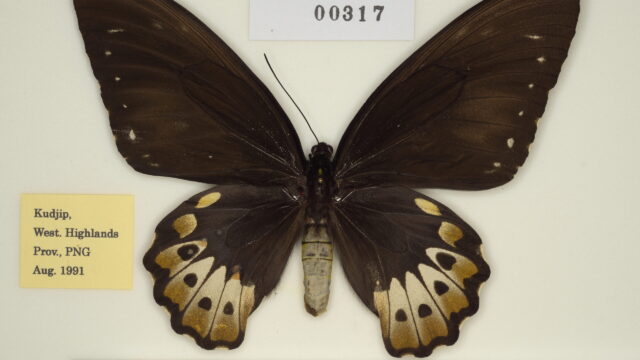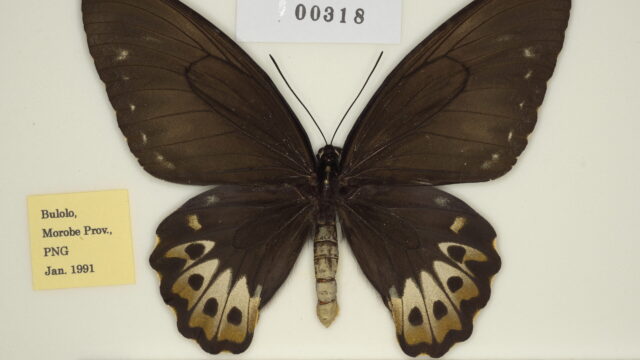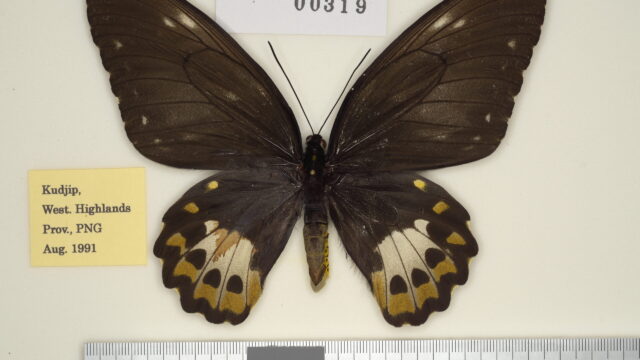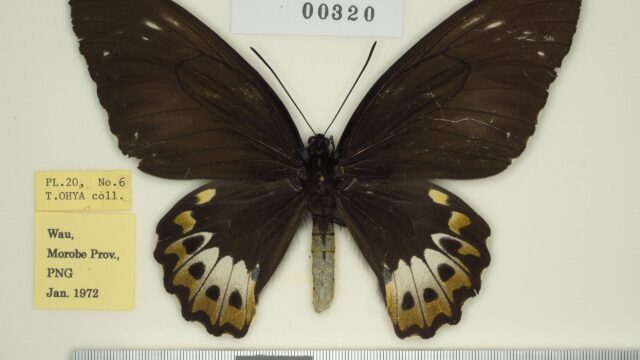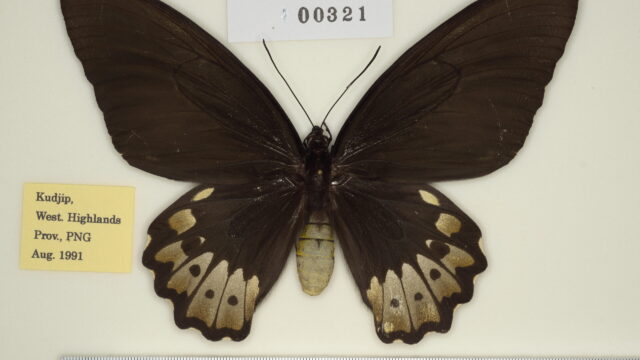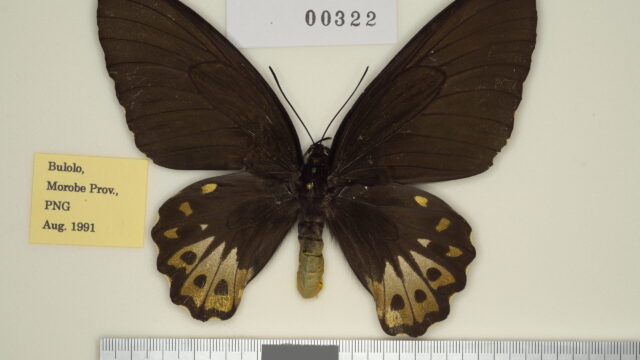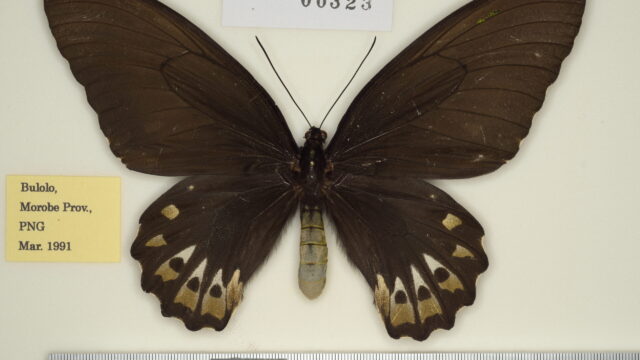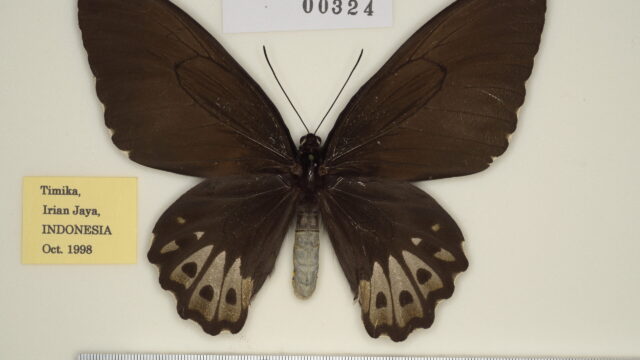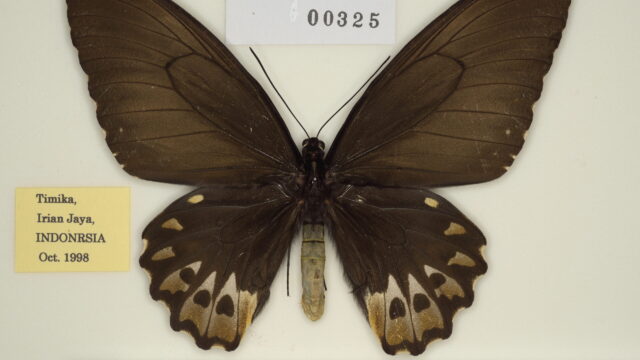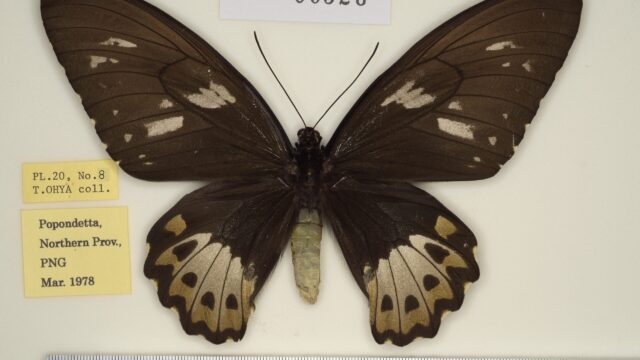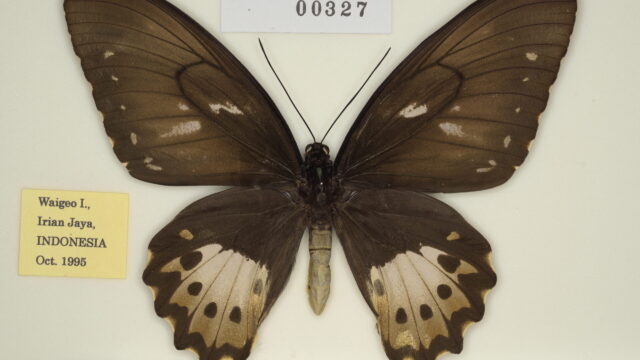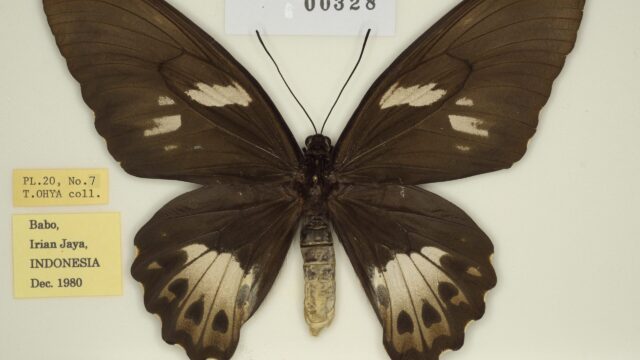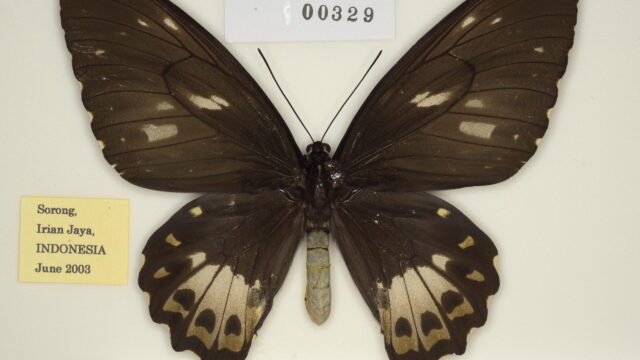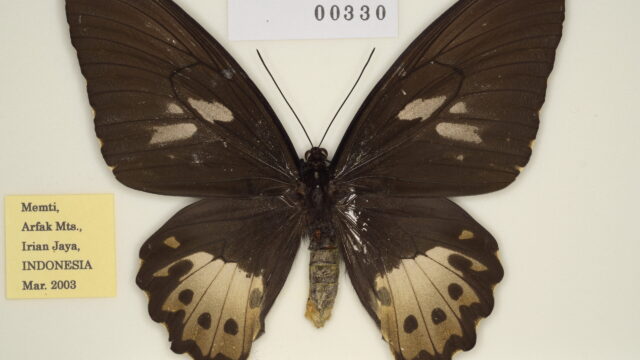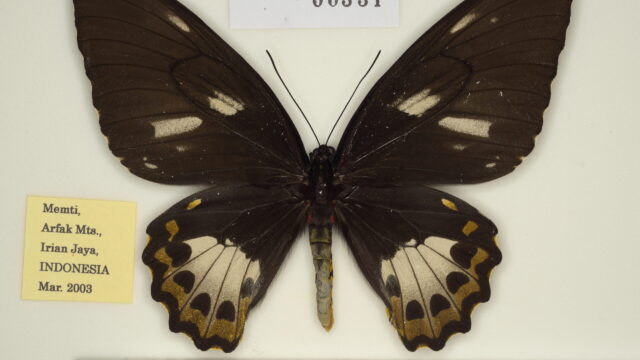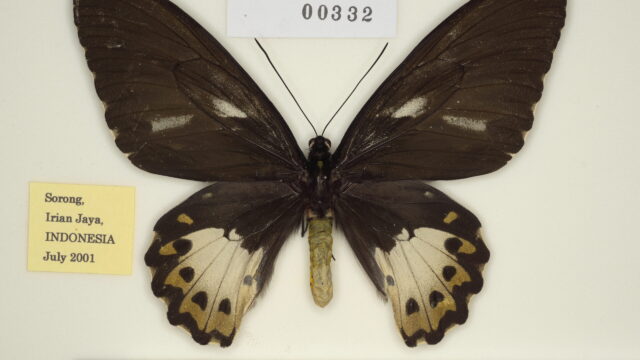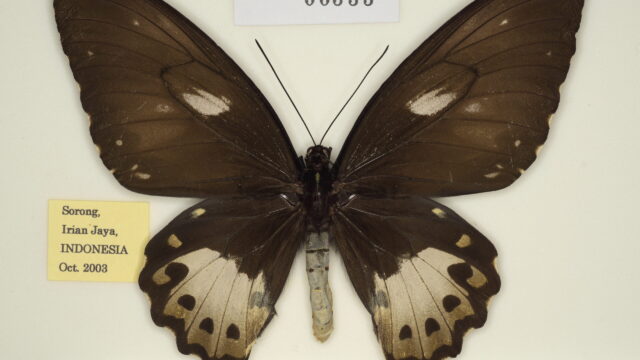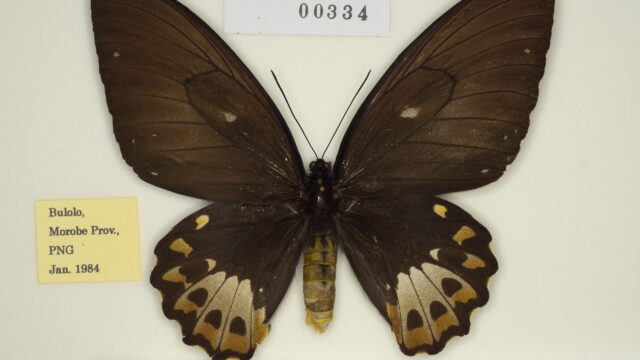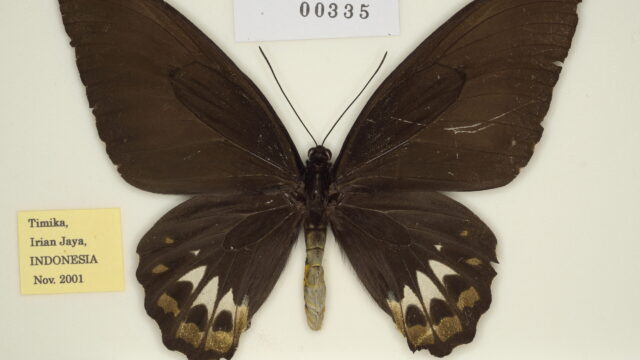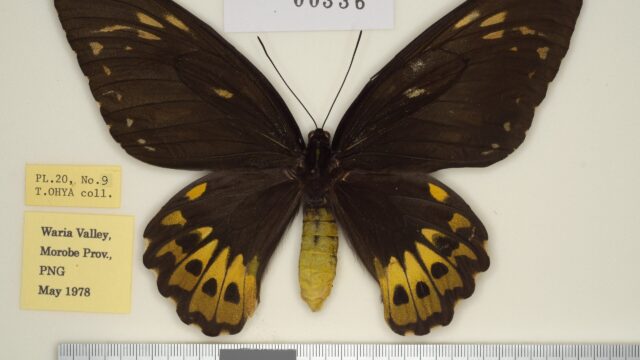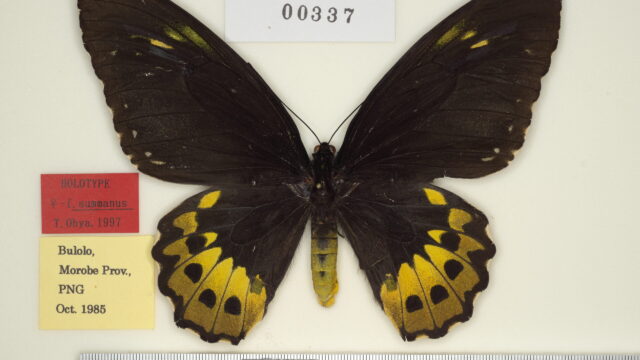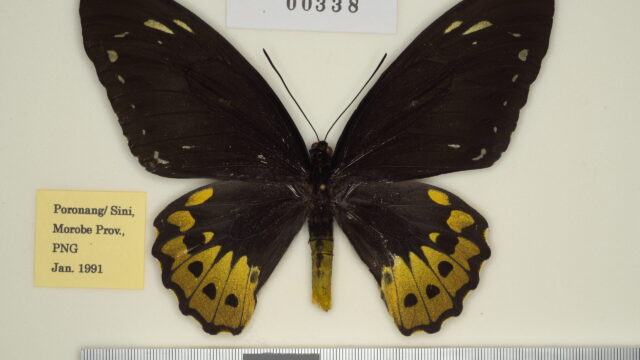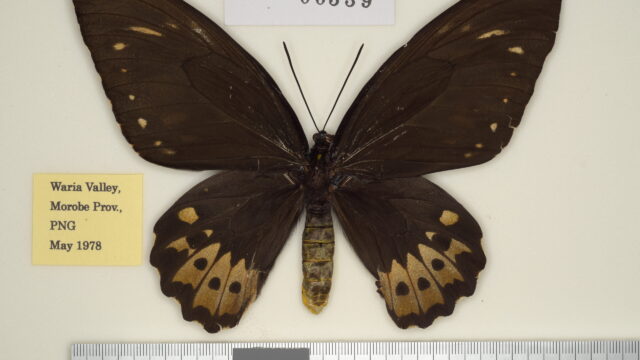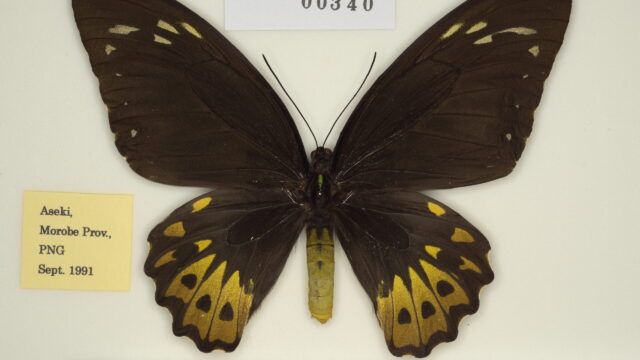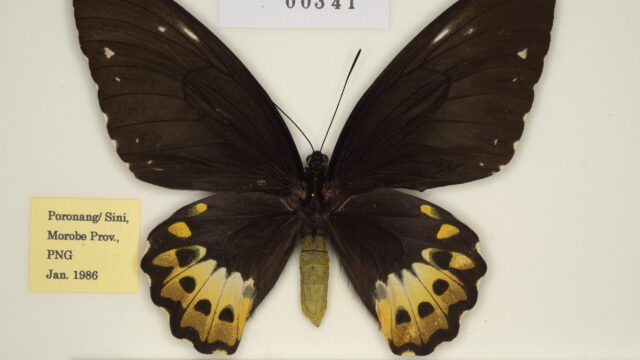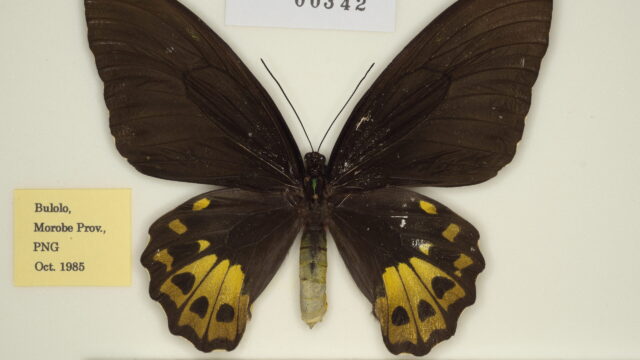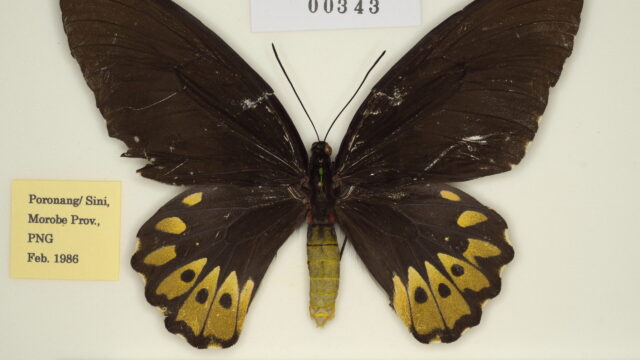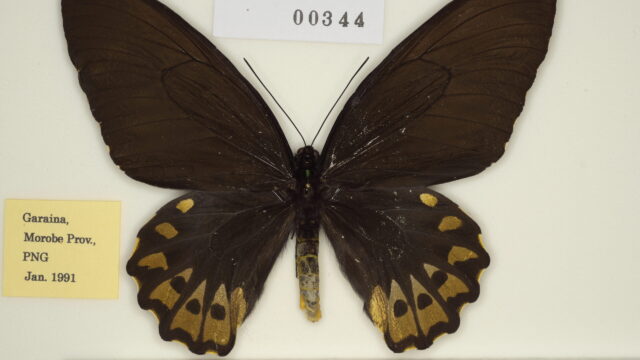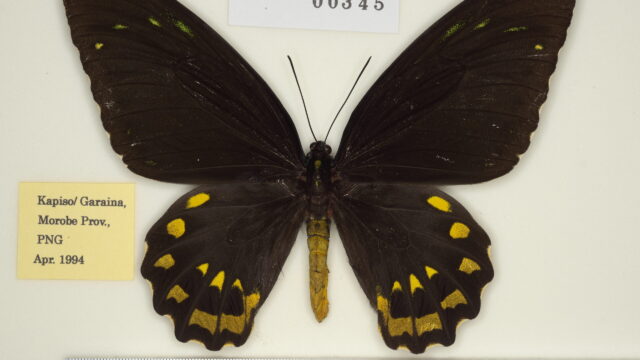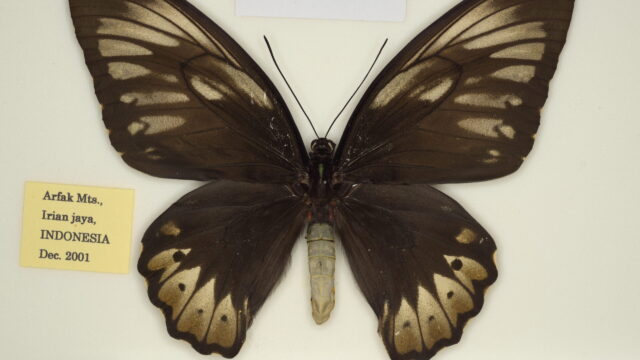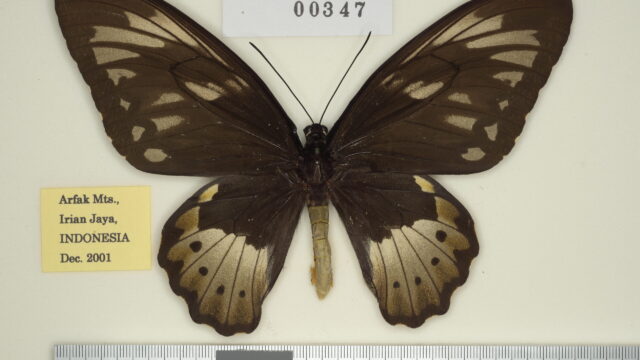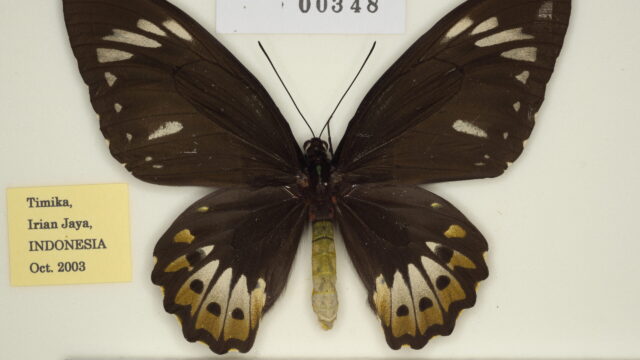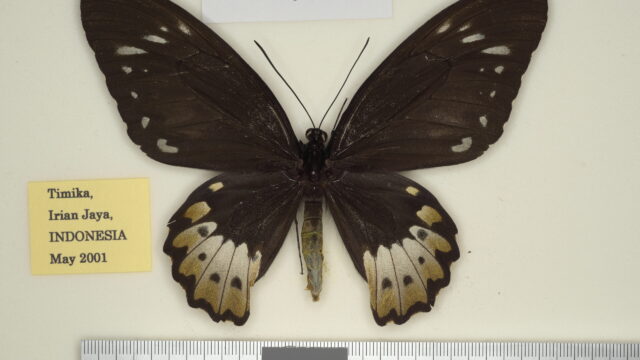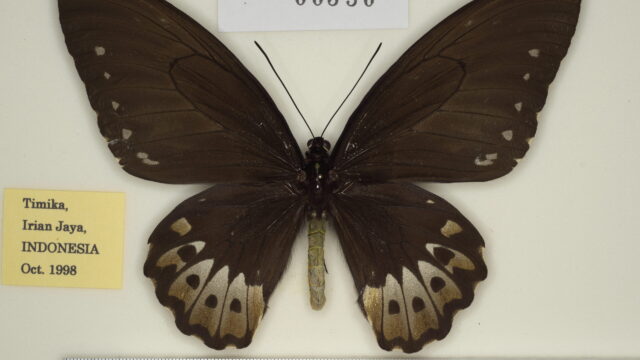11. Ssp. poseidon Doubleday, 184711) [♂] [♀: archideus (Gray, 1853)19)]
= archideus (Gray, 1853)19) [♀] (Waigeo Is.)
= pegasus (Felder, 1864)16) [♂, ♀] (S.W./N.W. Irian Jaya)
= valentina Vuillot, 189260) [♂, ♀] (N.E. coast of PNG)
= eudamidas Fruhstorfer, 191318) [♂, ♀] (Finschhafen, PNG)
= eurysaces Fruhstorfer, 191318) [♂, ♀] (Milne Bay, PNG)
= ornata (Niepelt, 1934)33) [♂, ♀] (Lelaki Is., Irian Jaya ?)
= aureus Parrott, 198741) [♂, ♀] (Arfak Mts., Irian Jaya)
= sterrensis Parrott, 199042) [♂, ♀] (Sterren (Kobowre) Mts., Irian Jaya)
= garainaensis Deslisle, 20047) [♂, ♀] (Garaina, PNG)
INDONESIA [Irian Jaya] Gag Is., Waigeo Is., Batanta Is., Salawati Is., Doberai Peninsula (Sorong, Mandopi, Manokwari, Marni, Arfak Mts. (Meni, Minyambow, Hingk, Memti, Sibjo), near Ransiki, Onin Peninsula (Fakfak), Panjang Is., Karas Is., Bomberai Peninsula (Kamrau Bay area, Etna Bay area, Adi Is.), Lake Yamur area, Nabire, Wanggar River basin, Kobowre Mts. (Sterren Mt.), Timika, Waren, Barapasi, Mamberamo River basin, Masi-Masi Is., Anus Is., Takar, Jayapura, Wamena, Agats, Merauke; PNG [WSP] Aitape, [ESP] But, Maprik, Ambunti, Wewak, Kondai, Kairiru Is., Mushu Is., [MgP] Madang, Manam (=Valcan) Is., Kar Kar (=Dampier) Is., Bagbag (=Rich) Is., Long Is., [WHP] Baiyer River basin, Mt. Hagen, Kudjip, [ChP] Mt. Wilhelm, Bogo, Kerowagi, [MoP] Umboi (=Rooke) Is., Finschhafen, Lae, Watut River basin, Bulolo, Wau, Aiuwa, Aseki, Aningi, Pauamunga, Waria River basin, Sini, Garaina, Morobe, [NP] Mambare River basin, Kumusi River basin, Popondetta, Afore, Wanigela, [MBP] Alotau, Sideia Is., Basilaki Is., [CeP] Mamai, Cape Rodney (Mori River basin), Kapogere, Sogeri, Port Moresby, Brown River basin, Yule Is., Tapini, [GP] Kikori, Ogomobu, [WP] Kiunga, Togo, Daru Is.; AUSTRALIA [Torres Strait] Darnley (=Erub) Is., Murray (=Mer) Is., Yam Is., Moa Is.
(Episodes of discovery and original description)
It was first described by Quoy & Gaimard (1824-1835) as a variation of Papilio priamus from a ♂ from Rawak Island. However, it was Doubleday (1847) who named it Poseidon, and he described it as an independent species based on the ♂ collected by Jukes on Darnley Island. On the other hand, the ♀ was first described by Gray (1853) as a subspecies archideus from Waigeo Island. The subspecies name “poseidon” is the name of a sea god in Greek mythology, corresponding to Neptune in Roman mythology.
(Characteristics)
It is only a representative of Poseidon-Subspecies-Group, which is the most widespread of all subspecies, but also a representative of species priamus. Because of its wide distribution, there are many local variations, and furthermore many individual variations, especially in the ♀, which mimics subgenus Schoenbergia are known. It can be thought that this subspecies branched off from the common ancestor of Priamus-Subspecies-Group at early stage and invaded New Guinea and expanded its range by taking advantage of its multi-species feeding habits.
(Spotted pattern)
♂: The apices of both FW and HW are acute. The anal and submarginal bands of FW are of almost equally wide and contiguous. The median stripe is mostly present. The outer margin of HW is narrow, and the number of black discal spots and submarginal semi-translucent golden spots varies by individual.
♀: Remarkably variable, every individual has its own pattern. There are two forms: dull (=pale) form (light brown ground color with shaded spots) and contrasted (=dark) form (blackish brown ground color with white spots), but in general the eastern species tend to belong to dull (=pale) form, and the western species tend to belong to contrasted (=dark) form.
(Variation)
♂-f. fuscuocellus Parrott & Deslisle, 198943): [Aberrant FW/HW pattern] FW underside without the black spots, thus uniformly green. Both sides of HW with three sub-marginal golden spots surrounded by brown scales and a subcostal golden spot.
♂-f. melania Schäffler, 200155) (=ripponi Deslisle & Sclavo, 201510)): [Aberrant FW/HW patteren] On FW surface, the radial band heavily reduced and the anal- and the submarginal bands faintly outlined, HW with strongly blackened subcostal zone.
♂-f. rochati Deslisle & Sclavo, 201510): [Aberrant FW/HW pattern] The radial and the submarginal bands narrower, but the median stripe wider on FW. HW with only three minute semi-translucent golden spots on the submarginal area and almost 2/3 of the costal marginal side blackened.
♂-f. viridocellularis Schäffler, 200155): [Aberrant FW pattern] FW with green spots within the black median area. (➡priamus )
♂-f. radians Parrott & Deslisle, 198943): [Aberrant FW pattern] FW with a subapical golden streak within the radial band, and a golden spot in space 5. There is a great expanse of green scaling in and beyond the cell.
♂-f. pabloi Deslisle & Sclavo, 201510): [Aberrant FW pattern] Two short green streaks present subapically within the black median area, and presence of scattered green scales within the cell (not forming a distinct solid patch). (➡macalpinei )
♂-f. marioi Deslisle & Sclavo, 201510): [Aberrant FW pattern] Three semi-translucent golden streaks present along cell costa and within spaces 8 and 9 subbasally on FW.
♂-f. aureopunctata (Dufrane, 1930)13): [Aberrant FW pattern] Two golden spots present within spaces 4 and 5 of the submarginal band on FW.
♂-f. poseidon Doubleday, 184711) (=ornata (Niepelt, 1934)33)): [Aberrant HW pattern] HW with several submarginal semi-translucent golden spots.
♂-f. cronius (Felder, 1864)16): [Aberrant HW pattern] HW without the black discal spots (the type of total absence of black maculation).
♂-f. nigropunctata (Dufrane, 1930)13): [Aberrant HW pattern] HW with a large black discal spot in space 4 and a minute one in space 3.
♂-f. pegasus (Felder, 1864)16): [Aberrant HW pattern] HW with several minute black discal spots.
♂-f. triton (Felder, 1864)16): [Aberrant HW pattern] Missing of the black macula on anal angle on HW underside.
♂-f. obscura (Niepelt, 1934)33): [Aberrant HW pattern] HW with subcostal space blackened and fused with the black discal spot within space 6.
♂-f. muckai Schäffler, 200155): [Aberrant HW pattern] HW without black discal spots, but entirely covered with scattered black scales.
♂-f. kerjoanti Deslisle & Sclavo, 201510): [FW/HW discoloration] Iridescent golden olive-green coloration of both FW and HW, instead of the typical green.
♂-f. flammeus Parrott & Deslisle, 198943): [FW discoloration] FW with the radial band having green, bright orange, bluish-gray and brown. The anal-submarginal band green, becoming orange towards its termination.
♂-f. ketchupabdominalis Attal, 19892): [Particular variation] Presence an orange-red patch on the dorsal abdomen.
♂-f. ishigakii Deslisle, 20047): [Specific mutation] FW is almost entirely green except for some golden streaks outside cell apex. HW is partially green and yellow with a submarginal row of four golden spots surrounded orange-brown scales.
♂-f. bilali Deslisle & Sclavo, 201510): [Specific mutation] Similar to ♂-f. pannis of O. (O.) croesus lydius. Both FW and HW green covered with pale brownish scales, except for the blackish sex-brand on FW. Numerous translucent golden spots present on FW, and large translucent golden spots on the subcostal and submarginal spaces (6 to 4) on HW.
♀-f. boreas (Fruhstorfer, 1901)17): [Aberrant FW/HW pattern] The cell-spot is absent and discal spots are small on FW. The pale band of HW is also reduced.
♀-f. albiplaga (Röber, 1937)48): [Aberrant FW/HW pattern] The cell-spot on FW absent (boreas-type). The pale band of HW is enlarged, but black discal spots are small.
♀-f. priameius (Röber, 1937)48): [Aberrant FW/HW pattern] On FW, the cell-spot consists of a long anterior streak and a small posterior one, and the subapical streaks are very long. The pale band of HW is reduced.
♀-f. radialei Parrott & Deslisle, 198943): [Aberrant FW/HW pattern] Very similar to ♀-f. priameius. Same aberration?
♀-f. beigeli Schäffler, 200155): [Aberrant FW/HW pattern] The subapical streaks and discal spots are enlarged, while the cell-spot is just a trace. HW pale band is slightly reduced, and dark discal spots are small.
♀-f. le moulti (Dufrane, 1946)14): [Aberrant FW/HW pattern] All spots on FW are largely fused with each other. The pale band on HW is also large, with white spot at the end of the cell.
♀-f. cecileae Deslisle & Sclavo, 201510): [Aberrant FW/HW pattern] All pale patches of FW are vestigial or missing, except the cell patch. The pattern of HW is reminiscent of ♀of O. (O.) c. croesus, but the pale band surrounded by grayish blue scales.
♀-f. paradoxa (Dufrane, 1930)13): [Aberrant FW pattern] The cell-spot and the discal spot of space 2 are greatly enlarged, while the other discal spots are minute or absent, on FW.
♀-f. archideus (Gray, 1853)19): [Aberrant HW pattern] The pale band is enlarged, and the pale spot is present on the end of the cell of HW.
♀-f. akakeoides Haugum & Low, 198122) (=aureus Parrott, 198741)): [Schoenbergia similar type] Black ground color with contrasting whitish patches. HW has strongly colored distal portion of the pale band and a tendency towards reduction of dark discal spots.
♀-f. pseudotroides Haugum & Low, 198122): [Troides similar type] FW is black without pale spots. HW is normal pattern, but color of pale band and abdomen are deep yellow.
♀-f. titanoides Sumiyoshi, 198958): [O. goliath titan similar type] Similar to the above mutation. FW is black without any white markings. Pale band of HW is yellow, but short, and dark discal spots are small and solitary.
♀-f. gabrielleae Deslisle & Sclaco, 201510): [O. goliath titan similar type] Similar to the above mutation. FW is entirely black. The pale band of HW is enormously reduced without the dark discal spots and grayish in color.
♀-f. summanus Ohya, 199736): [FW/HW discoloration] Troides-type. FW black, except for a low of minute subapical streaks and submarginal spots. The most prominent feature is that the first and second subapical streaks are covered with iridescent grayish green scales. HW pale band and abdomen are deep yellow.
♀-f. nivalis Fruhstorfer, 191318): [FW/HW discoloration] The spots of FW and the pale band of HW is white instead of normal cream color.
♀-f. aurago Fruhstorfer, 191318): [FW/HW discoloration] The pale band of HW is deep ocher. There are traces of yellow scales on the cell of FW underside (white on upper side).
♀-f. alixiae Deslisle & Sclavo. 201510): [FW/HW discoloration] FW is almost black except for a fine green subapical streak, and three minute green and two white submarginal spots. The pale band of HW is yellow, feebly shaded by brown scales submarginally. The dark discal spots are heavily scattered by green scales apically.
♀-f. michikoae Sumiyoshi, 198958) (=viridocoronae Deslisle & Sclavo, 20089)) [FW/HW discoloration] Spots generally yellow. Green scales are densely packed around FW spots to form green spots and sometimes they appear also near the cell of HW.
♀-f. kirschi Oberthür, 188835): [FW discoloration] FW resembles ♀-f. aurago, but in this aberration FW cell is yellow not only the underside but also upper side.
♀-f. decora (Niepelt,1934)33)(=raymondeae Deslisle & Sclavo, 201510)) [FW discoloration] The cell-spot of FW is yellowish with iridescent green scales. The pale band of HW is also yellowish.
♀-f. lavata Fruhstorfer, 191318): [HW discoloration] Absence of yellow pigmentation on the submarginal area of pale band of HW underside.
♀-f. ishigakii Deslisle, 20047) [Specific mutation] Wings are entirely white except for the black basal area, the black veins, and the black marginal border. Similar to ssp. euphorion ♀-f. weylandi. The poler type of white color.
♀-f. multicolorei Parrott & Deslisle, 198943): [Specific mutation] Iridescent green scales dividing cell-spot in two, both framed by pale blue or blue-gray color on FW. Dark discal spots on HW are extremely large and fused together; pale blue scales are present apically dark discal spots and along the veins and inside of cell-end, moreover green scales are present along the lower cell vein (=cubitus).
♀-f. bernadineae Deslisle & Sclavo, 201510): [Specific mutation] FW cell is entirely white. It is divided in three nearly equal parts with scarce iridescent scales, green basally, gradually becoming yellow and dark blue apically.
♀-f. bertounesquei Deslisle & Sclavo, 201510): [Specific mutation] FW resembles ♀-f. radialei, but the cell-spot and subapical streaks almost yellow. HW pale band is shortly white basally, progressively changing to yellow, reaching submarginal region, which is uniformly shaded by brown scales without any dark discal spots.
